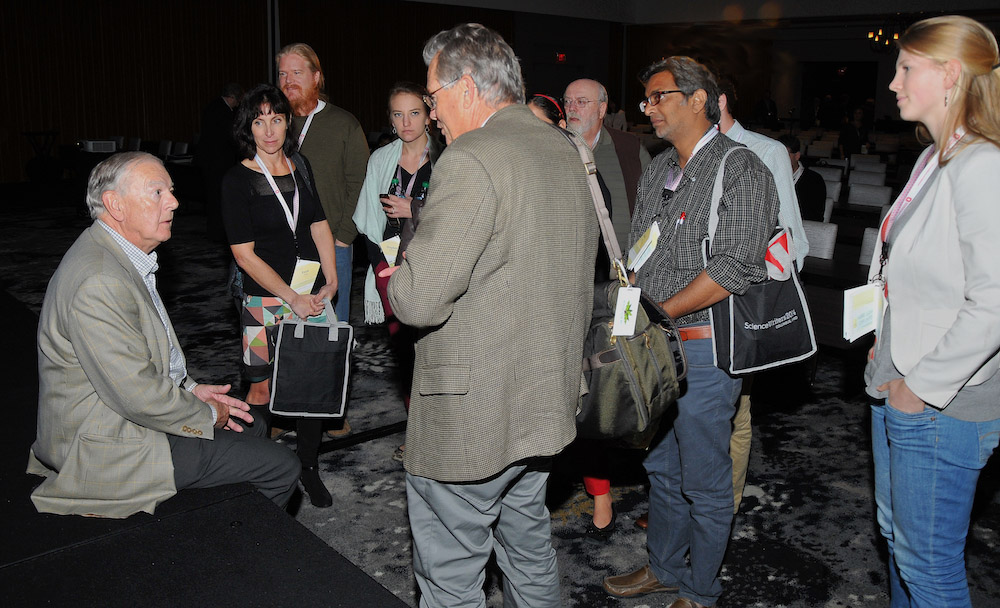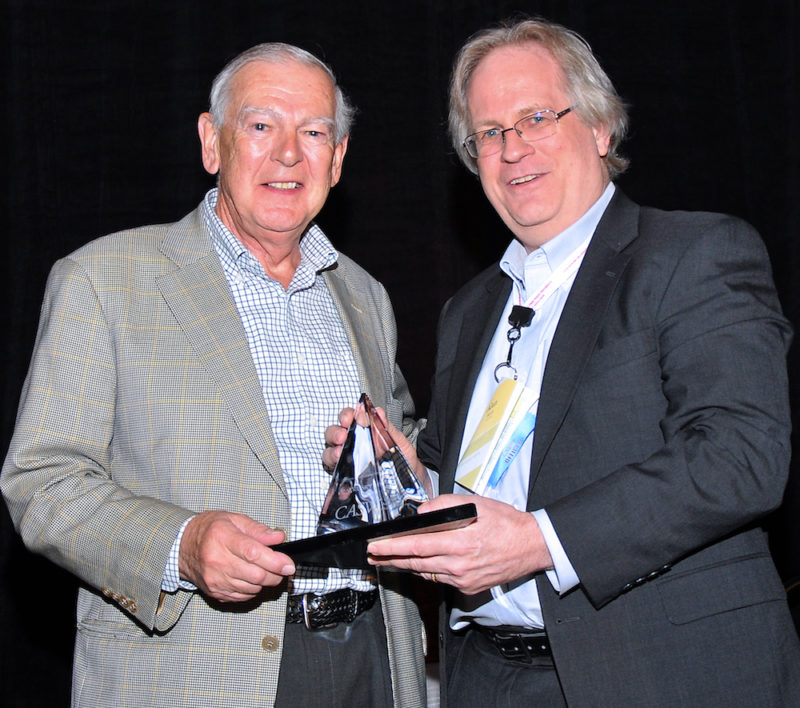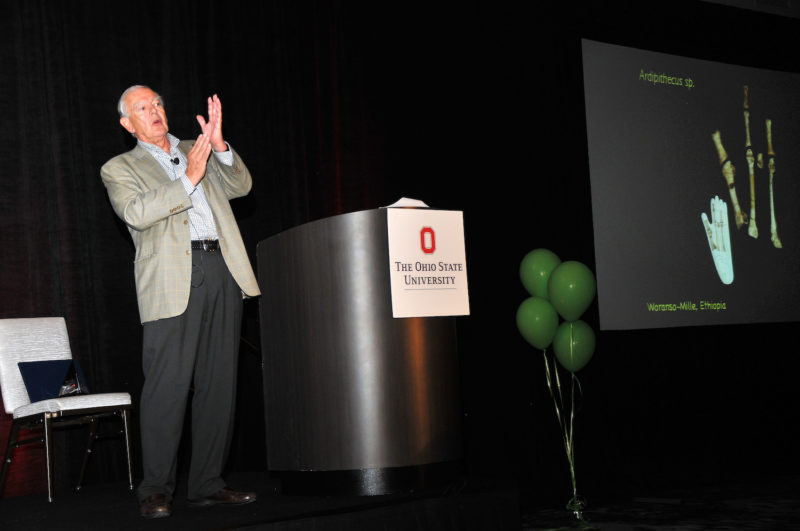
Don Johanson gives Patrusky Lecture marking 40th anniversary of Lucy’s discovery
Charlie Petit asks Don Johanson a question after Johanson’s Patrusky Lecture on October 19, 2014.
In the second Patrusky Lecture at CASW’s New Horizons in Science, paleoanthropologist Donald Johanson of Arizona State Univeresity traced the sweep of knowledge about the human family tree, insisting that human survival may depend on understanding the journey that brought Homo sapiens into existence.
The lecture, called “The Human Evolutionary Journey” and given in Columbus, Ohio on October 19, 2014, on the eve of the 40th anniversary of Johanson’s discovery of the fossil hominid Lucy, traced the discoveries that have extended the human family back more than 6 million years. Among these is a recent finding of an Ardipithecus fossil with a divergent great toe in Ethiopia near the Lucy site—one of many finds that may shed light on the paths early hominids took to walking upright.
Many species of the genus Homo are now known to have evolved from prehuman species in Africa, Johanson noted, and current work is filling in gaps to explain how modern humans developed their characteristic cognitive complexity, linguistic flexibility and capacity for culture and cooperation.

Lucy’s discovery marked a watershed moment in the study of hominid evolution. Johanson, founding director of the Institute of Human Origins, is best known for that find and the subsequent analysis, which changed scientists’ view of how prehuman hominids came to walk upright. He has spent his career discovering clues to human origins through uncovering and analyzing fossil evidence from Africa.
Johanson’s audience was science writers gathered for ScienceWriters2014, a conference that combines the New Horizons science presentations, hosted this year by Ohio State University, with professional workshops organized by the National Association of Science Writers. A recording may be found on the Patrusky Lectures video page.
The Patrusky Lecture was established last year by the CASW Board of Directors in honor of CASW Executive Director Emeritus Ben Patrusky, who managed the New Horizons program for 30 years and served as the organization’s executive director for 25 years. The inaugural lecture was given in November 2013 by celebrated chemist and materials scientist George M. Whitesides of Harvard University.
About Don Johanson
Determined to be a scientist from childhood, Don Johanson earned his Ph.D. in anthropology at the University of Chicago. In 1974, he had just received his doctorate and joined Case Western Reserve University as a junior faculty member when he and colleagues mounted a search for hominid fossils at Hadar, located in the Afar Triangle of Ethiopia. On that trip, Johanson found the partial skeleton that changed the conventional account of human evolution, which had been developed based on much more fragmentary fossils.
Returning the following year, Johanson and colleagues found the remains of at least 13 individuals at the Afar site in Hadar. Johanson called these the First Family and argued that they were of a single, new species, Australopithecus afarensis. Lucy and the First Family fossils have been estimated to be 3.18 million years old.
Johanson analyzed the fossils at the Cleveland Museum of Natural History, where he was appointed curator of physical anthropology in 1975. He developed a laboratory there that attracted scholars from all over the world. In 1981, he founded the Institute of Human Origins in Berkeley, Calif., to conduct field and analytical research on the early human fossil record. IHO moved to Arizona State in 1997. Johanson turned over the directorship to William Kimbel in 2009.
Before the discovery of Lucy, the dominant theory was that early humans developed big brains, became capable of making tools, and then began walking upright to free up their hands. Lucy and the other hominids whose remains were found at the site were walking upright, but had small brains and showed no evidence of using tools. A different theory for the evolution of bipedalism was needed.
The discovery of hundreds of other fossils at Hadar bolstered the view that A. afarensis was a distinct species that is widely thought to be the common ancestor to subsequent species of both Australopithecus and Homo. In addition, a great deal has been learned about prehuman evolution from the study of the Hadar fossils, and A. afarensis has become the benchmark by which other ancient hominid species are evaluated. Johanson has used the Lucy story extensively to excite and inform the public about human origins research. He has authored or co-authored several books, including Lucy: The Beginnings of Humankind (1991); Ancestors: In Search of Human Origins (1994); From Lucy to Language (2006); and Lucy’s Legacy: The Quest for Human Origins (2010). His Webby-winning website www.becominghuman.org is used worldwide as a powerful learning tool for students from elementary school through the university level.

Since 1980, Johanson has participated in the production of documentaries and online resources on human evolution. He appeared as the narrator and on-screen host of an Emmy-nominate three-part NOVA series in 1994. He continues to conduct fieldwork and a field school in Hadar and teach at ASU and most recently was featured on the PBS series “Your Inner Fish.” Following a five-year visit to the US as part of a touring exhibit, Lucy is now back at the Ethiopian National Museum in Addis Ababa. Her discovery in 1974 launched multiple research programs in Ethiopia that have resulted in discoveries of human ancestor fossils that stretch back to nearly six million years ago.
Johanson holds the Virginia M. Ullman Chair in Human Origins in ASU’s School of Human Evolution and Social Change. Recipient of many international prizes and awards, he is a Fellow of the Royal Geographical Society and a member of the Siena Academy of Sciences. With support from the National Science Foundation, the L. S. B. Leakey Foundation and the National Geographic Society, he has carried out field research in Yemen, Saudi Arabia, Egypt, Jordan and Tanzania as well as Ethiopia.